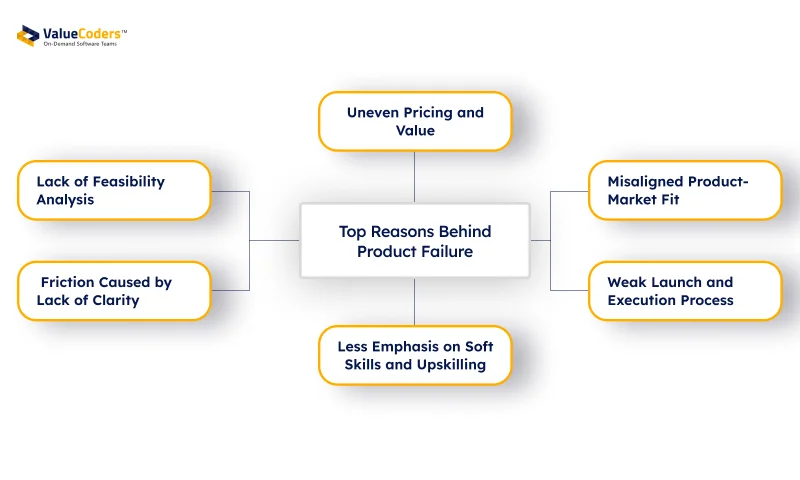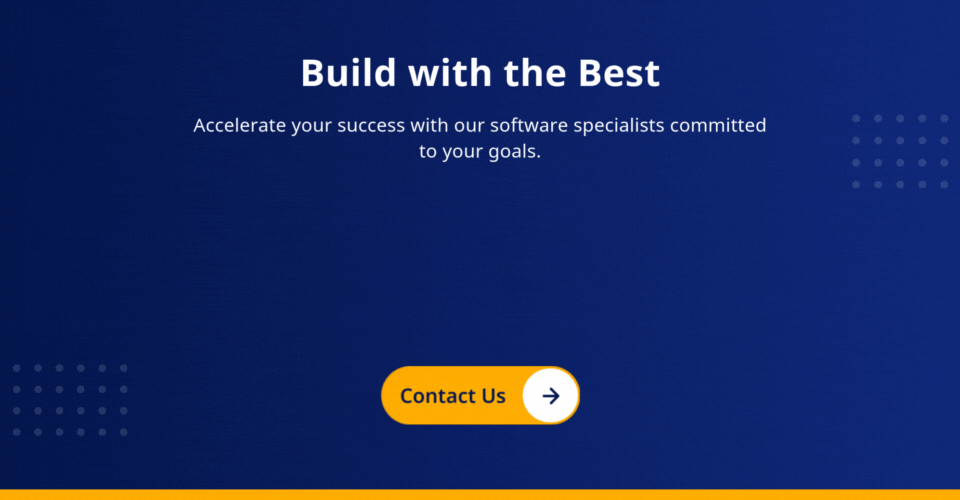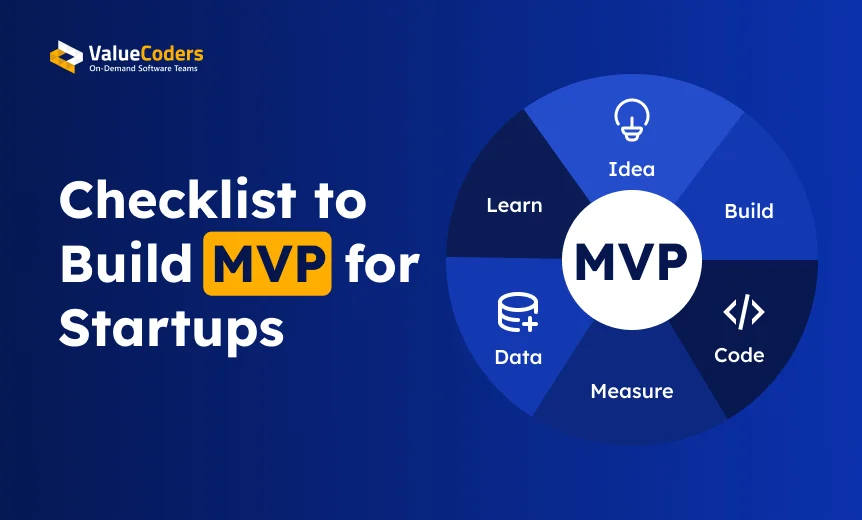Even with limited budgets and brilliant ideas, many startups still see their software fail in the market. Why does this happen so often and how can young businesses avoid becoming part of the 95% failure rate?
The software industry continues to expand at breakneck speed, with global spending exceeding $600 billion annually. Yet beneath this impressive growth lies a troubling reality: roughly 95% of new software products fail to deliver on their promises.
By examining the root causes of software product disappointments, we can uncover practical ways to beat the odds. The lessons learned from these failures serve as valuable guideposts for businesses hoping to create products that deal with poor software product management.
Top Reasons Why Software Products Often Fail
Software product failure is a multifaceted issue. It is not just about whether a product is great enough or in high demand. It can be a product that fails to solve the problem it was designed to solve, struggles to scale, has technical incompetence, and faces many other product development challenges.
Check out the top reasons why new software products often fail in the market:
1. Misaligned Product-Market Fit
Startups often rush into development under investor or timeline pressure, skipping real user validation. This leads to wasted funding on features nobody actually needs.
Consider the case of Google Glass. Despite impressive technology, it failed to address genuine user problems and ultimately fizzled out. Similarly, countless startups build products nobody wants because they skipped the crucial step of validating demand.
Getting product-market fit right means:
- Confirming a real problem exists before building anything
- Testing assumptions with actual potential users
- Understanding the willingness to pay for solutions
- Mapping the competitive landscape accurately
When teams rush past these steps, they end up with technically sound products that nobody wants or needs.
2. Weak Launch and Execution Process
Even great products can fail with poor execution. That’s why startups often invest in MVP development services.
Common execution missteps include:
- Releasing products before they’re truly ready
- Failing to build pre-launch excitement
- Missing crucial feedback windows
- Under-investing in user onboarding
- Not having clear success metrics for the launch phases
Software requires thoughtful rollout plans that consider everything from testing sequences to market education and support readiness.
3. Lack of Feasibility Analysis
For early-stage founders, underestimating feasibility leads to missed deadlines and rushed pivots, often when they can least afford mistakes.
Real-world constraints like:
- Available engineering talent
- Technical debt limitations
- Infrastructure scaling challenges
- Security requirements
- Compliance hurdles
These factors must be honestly assessed before making commitments. When ignored, they lead to missed deadlines, buggy features, and disappointed stakeholders.
Stop guessing—work with our product experts to build software that succeeds from day one.
4. Friction Caused by Lack of Clarity
Unclear requirements breed confusion across engineering, design, and business teams. When vision isn’t properly communicated, different team members work toward conflicting goals.
This friction manifests as:
- Inconsistent feature implementations
- Misaligned priorities
- Wasteful rework cycles
- Decision paralysis
- Team frustration
Clear product documentation, well-defined success metrics, and open communication channels help minimize these product development challenges.
5. Less Emphasis on Soft Skills and Upskilling
Technical excellence alone doesn’t guarantee product success. Many software teams overlook crucial soft skills like:
- Customer empathy
- Clear communication
- Conflict resolution
- Giving/receiving feedback
- Change management
Without ongoing investment in these capabilities, even talented teams struggle to adapt to shifting requirements or collaborate effectively during challenging development cycles.
6. Uneven Pricing and Value
Many software products fail because their pricing doesn’t match perceived value. Either they charge too much for limited functionality or undervalue their offering, making sustainability impossible.
Pricing pitfalls include:
- Complex pricing structures that confuse buyers
- Failing to account for true development costs
- Not considering competitive alternatives
- Missing opportunities for tiered offerings
- Ignoring customer acquisition costs in pricing models
Software that delivers tremendous value but can’t sustain development through appropriate pricing is destined to fail.
Also Read: Top 11 Software Product Development Companies
Key Factors Affecting Software Product Success
Every successful software product shares a few critical traits. Let’s explore the core factors that separate the winners from the ones that never quite take off.
1. Desirability
Software succeeds when it solves real problems that matter to users. Desirable products aren’t just functional; they’re intuitive and enjoyable and fit seamlessly into users’ lives.
Signs of high desirability include:
- Users are actively seeking out the solution
- Low customer acquisition costs
- Strong word-of-mouth referrals
- Customers are willing to pay premium prices
- High engagement metrics
The most successful software makes users feel more capable, connected, or accomplished, addressing emotional needs alongside functional ones.
2. Ethicality
Software must be built with integrity and respect for users. Ethical considerations to reduce software project risks include:
- Data privacy practices
- Transparency in communications
- Fair monetization approaches
- Accessibility for diverse users
- Environmental impact of infrastructure
Products that cut corners on ethics face growing backlash from consumers and regulators alike, leading to reputation damage and eventual failure.
3. Viability
Business viability determines whether software can succeed long-term. Key aspects include:
- Sustainable revenue models
- Realistic customer acquisition channels
- Manageable operating costs
- Clear competitive advantages
- Scalable infrastructure
Many technically impressive products fail simply because they lack viable business models to support ongoing development and maintenance.
4. Feasibility
Technical feasibility addresses whether a product can be built as envisioned, within reasonable constraints. Important considerations include:
- Technical complexity assessment
- Required specialist knowledge
- Timeline realism
- Maintenance burden
- Technology stack limitations
When teams underestimate feasibility challenges, they set themselves up for painful compromises, missed deadlines, and broken promises.
At ValueCodetrs, we help you stop wasting time/resources and master the keys to software success.
Key Strategies For Successful Product Development
Turning an idea into a usable, loved product takes more than just coding. The following strategies will help keep your next launch on track and on point.
1. Understand Your Target Market
Successful products begin with deep customer knowledge:
- Map customer jobs, pains, and gains
- Segment users by needs, not just demographics
- Track changing market conditions
- Study competitive alternatives
- Build detailed user personas based on research
This foundation prevents building software product development solutions in search of problems.
2. Use a People-First Development Approach
Technology serves humans, not the reverse. People-first development means:
- Considering accessibility from day one
- Testing with diverse user groups
- Designing for emotional as well as functional needs
- Building intuitive interfaces that reduce learning curves
- Respecting user time and attention
When human needs drive decisions, software succeeds more often.
4. Hire Dedicated Software Teams
It emphasizes outsourcing, staff augmentation, or hiring lean dedicated teams
Dedicated teams provide:
- Established working patterns
- Accountability for outcomes
- Continuity through project phases
- Faster problem-solving
The right team structure significantly improves software success rates.
Also Read: Top 11 Software Product Development Companies In Delhi-NCR
5. Foster a Culture of Continuous Learning
It frames as staying ahead with new frameworks & avoiding legacy tech traps that startups often fall into.
Continuous learning ensures:
- Regular skill-building opportunities
- Knowledge sharing sessions
- Post-mortem reviews of successes and failures
- External training investments
- Technical mentorship programs
Teams that stop learning quickly fall behind, producing outdated solutions.
6. Track External Influential Factors
No software exists in isolation. External factors to monitor include:
- Regulatory changes affecting your domain
- Competitor movements
- Technology platform shifts
- Economic conditions impacting customers
- Demographic trends in target audiences
Staying aware of these factors helps prevent being blindsided by market changes.
The software products we build have a 4.6+ average app rating across 20+ industries.
7. Use Data Analytics
Make decisions based on evidence, not assumptions:
- Implement robust usage tracking
- Establish clear metrics for success
- Test hypotheses systematically
- Review both quantitative and qualitative data
- Share insights across teams
Data-informed decisions consistently outperform gut feelings in software development.
8. Don’t Accumulate Technical Debt
Short-term shortcuts create long-term problems:
- Budget time for refactoring
- Document code thoroughly
- Maintain consistent quality standards
- Automate testing where possible
- Address bugs promptly before they compound
Managing technical debt preserves future agility and prevents increasingly painful maintenance cycles.
9. Use an Agile Approach
Flexible, iterative processes outperform rigid planning:
- Break work into small, valuable increments
- Gather feedback frequently
- Adapt plans based on new information
- Focus on delivering business value early
- Maintain sustainable work rhythms
Agile approaches help teams respond to changing requirements while maintaining productivity.
Conclusion
The sobering 95% failure rate for software products isn’t inevitable; it’s a warning sign. For those worried about wasting resources on failed software ventures, understanding these common pitfalls provides a roadmap for success.
The most successful software companies combine technical excellence with market awareness, disciplined execution, and human-centered design thinking. They test assumptions early, build incrementally, and listen carefully to users throughout the development process.
While building great software remains challenging, the rewards for getting it right are tremendous. You can connect with our experts to build your next software product. We have been a leading software development company in India since 2004.
At ValueCoders, We have been providing software development services to our global clients. To date, we have successfully delivered 4,200+ projects. Contact us today!








